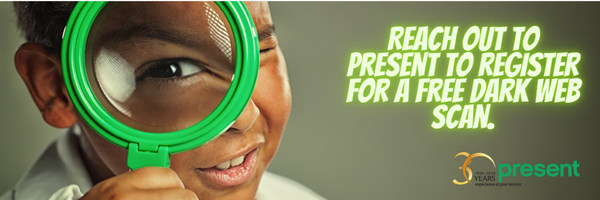Present Blog – IT Thought Leadership
Blog Present-IT thought leadership
Blog Present-IT thought leadership
IT thought leadership blog for CIOs and CTOs in Canada seeking resources to drive IT as a business contributor: hybrid cloud, infrastructure, managed services and security and IT recruitment.
 In today's digital age, the security of our personal and corporate online accounts is more critical than ever. With the increasing number of data breaches, it's essential to understand the risks associated with the dark web and how to protect your sensitive information.
In today's digital age, the security of our personal and corporate online accounts is more critical than ever. With the increasing number of data breaches, it's essential to understand the risks associated with the dark web and how to protect your sensitive information.
What is the Dark Web?
The dark web is a hidden part of the internet that is not indexed by traditional search engines like Google. It requires special software, such as the Tor browser, to access. While the dark web has legitimate uses, it is also a hotspot for illegal activities, including the buying and selling of stolen data.
How Does Your Information End Up on the Dark Web?
When hackers infiltrate organizations and companies, they often steal sensitive data, including usernames, passwords, and other personal information. This stolen data is then sold on the dark web to the highest bidder. Unfortunately, this means that your corporate information could be circulating on the dark web without your knowledge.
Steps to Protect Yourself
1. Use Strong, Unique Passwords: Have you ever thought about how long it would take for a hacker to crack your password using today's technology and just a basic desktop computer?
Let’s take the example of a seven-character password that contains only numbers. Using a typical desktop computer that password can be cracked in about 4 seconds! If you only had letters, that would take about 50 minutes. If you used uppercase and lowercase letters would take about four days. If you used uppercase lowercase and numbers, the numbers goes up to about two weeks and using uppercase, lowercase, numbers and symbols would take about a month!
If you bumped that up to eight characters instead of seven, it would now take seven years!
So, it goes without saying that it is key to create complex passwords that are difficult to guess and avoid using the same password across multiple accounts.
2. Enable Two-Factor Authentication (2FA): Two-factor authentication adds an extra layer of security by requiring a second form of verification, such as a code sent to
your phone, in addition to your password. This makes it much harder for hackers to gain access to your accounts.
3. Use a Password Manager: Password managers can generate and store complex passwords for you, reducing the need to remember multiple passwords. They also help you avoid reusing passwords across different accounts.
4. Be Cautious with Public Wi-Fi: Avoid accessing sensitive accounts over public Wi-Fi networks, as they can be easily intercepted by hackers. Use a virtual private network (VPN) to encrypt your internet connection when using public Wi-Fi.
5. Educate Yourself and Your Team: Stay informed about the latest cybersecurity threats and best practices. Regularly train your team on how to recognize and respond to phishing attempts and other cyber threats.
Conclusion
The dark web poses a significant threat to the security of both personal and corporate information. By understanding how your data can end up on the dark web and taking proactive steps to protect your corporate data, you can minimize the risk of falling victim to cybercriminals. Implementing strong, unique passwords, enabling two-factor authentication, using password managers, being cautious with public Wi-Fi, and educating yourself and your team are essential measures to safeguard your sensitive information. Stay vigilant and prioritize your online security to keep your corporate data safe from malicious actors.
Want to check if Your Information is on the Dark Web?
Present offers a one time, no cost dark web report. Many organizations are taken aback when they discover their employees’ access credentials being sold on the dark web. Regardless of whether you run a large enterprise or a small to mid-sized business, it’s crucial to ensure you’re not an easy target!
About Blog
The right use of technology addresses business challenges and drives business growth in all areas of an enterprise. We hope this blog will offer insight into developing strategies and tactics to enable you to identify those key drivers of growth and keep pace with and anticipate the rapid technology change of today.
Posts by Topic
- IT infrastructure (116)
- IT security (92)
- IT Innovation (59)
- Trends (51)
- Cloud (47)
- Managed services (46)
- Mobility (38)
- Digital transformation (29)
- CIO/IT leaders (28)
- Events (28)
- News (23)
- Microsoft 365 (17)
- Security (17)
- IBM (16)
- Disaster recovery (DR) (14)
- High availability (12)
- Recruitment (12)
- Storage (12)
- Big Data (11)
- Collaboration (11)
- AI (9)
- Case study (9)
- Office 365 (9)
- BYOD (8)
- Customer Experience (8)
- Hybrid Cloud (7)
- Current events (6)
- SAP Hana (5)
- Business intelligence (BI) (4)
- Converged infrastructure (4)
- Convergence / Hyper-convergence (4)
- Virtualization (4)
- Copilot (3)
- Future of retail (2)
- Retail (2)
- trend (2)
- Backups (1)
- Beacon (1)
- Blog Migrations (1)
- Contests (1)
- Infrastructure TI (1)
- Innovation TI (1)
- IoT (1)
- MDM (1)
- Stockage (1)
- Virtualisation (1)
- blockchain (1)
- cio (1)
- replication (1)
- Étude de cas (1)
